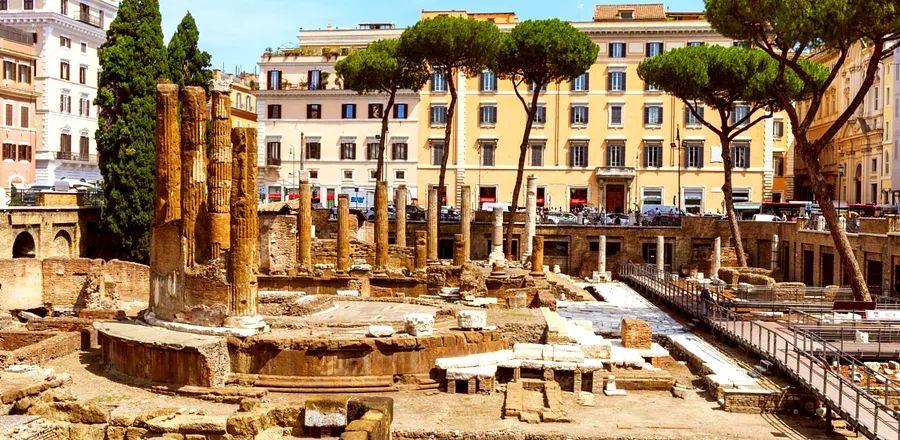Fresh Hotels, Dining, and Adventures: Why You Should Plan a Trip to Rome Now

Our meal began with octopus carpaccio, wagyu beef gyoza, and yellowtail sushi. After my husband and I finished those, the waiter brought out Ibérico pork marinated in soy and truffle. Sitting on a winding banquette at Seen by Olivier, the rooftop dining venue at the new Anantara Palazzo Naiadi hotel, we savored dish after dish. When I first lived in Rome back in 2009, it was difficult to find such globally inspired cuisine; despite being a major European capital, the city had leaned heavily towards traditional dishes. But the Eternal City is evolving.

Photo by Nikolas Koenig
Anantara is among several hotel brands adding a more international vibe to the city. In 2023 alone, InterContinental, Bulgari, Edition, and Six Senses opened new properties in Rome. Upcoming are hotels from Four Seasons, Rosewood, Nobu, and others. "Rome is emerging from a tumultuous year filled with tourists and new openings," says Elisa Valeria Bove, CEO of the private tour company Roma Experience. "Previously, visitors would stay in Rome for two or three days. Now, they’re extending their stays to five, six, or even a week."
Bove and others in the city's tourism sector are optimistic that the surge of high-end hotels, with their array of amenities and dining options, will draw in wealthier travelers who tend to spend more time and money, thereby enhancing the local economy and encouraging visitors to explore beyond the most famous (and often crowded) sites.
“Rome has long been a stop-and-go destination for tourists checking off the Vatican and Colosseum,” Bove remarks. “However, visitors are now more willing to discover other attractions—and Rome has so much to offer. It would take a lifetime to uncover it all.”
Having lived here full-time since 2019, I can personally vouch for the multitude of hidden gems this city possesses—if only visitors take the time to seek them out. Travelers can enjoy a picnic under the ancient aqueducts at Parco degli Acquedotti; admire Raphael's Renaissance frescoes in the Church of Santa Maria della Pace; catch a glimpse of modern aristocratic life at Palazzo Colonna, which opens part of its doors to the public on Fridays and Saturdays; or explore contemporary art galleries in San Lorenzo, a neighborhood that has become a vibrant hub for artists.
It’s no wonder that Rome continues to evolve and adapt; the city has embraced foreign influences and lifestyles since the era of the Roman Empire. Evidence of this transformation is visible throughout, as the city consistently excavates its past while reconstructing its present. This thought crossed my mind during a recent visit to Largo di Torre Argentina—the historical site of Julius Caesar's assassination. Medieval structures had concealed the ruins until Benito Mussolini demolished the pre-Renaissance buildings in the 1920s under the guise of progress. After years of neglect, funding from luxury brand Bulgari facilitated its public opening in June 2023. Despite having walked past these ruins countless times, viewing archival photos of the excavations in the new exhibition space was a poignant reminder that progress is often a cyclical journey.

Courtesy of Anantara Palazzo Naiadi Rome
Located about a mile to the north, extensive renovations are underway at Piazza Augusto Imperatore, a site where Mussolini demolished significant parts of the city in the 1930s to create a plaza honoring the Roman emperor of the same name (and to assert his legacy). Since June 2023, the square has welcomed the 114-room Bulgari Hotel Roma, featuring two restaurants helmed by chef Niko Romito (co-owner of the three Michelin-starred Reale in Abruzzo, a region to the east of Rome). The next phase of the project aims to redesign the area surrounding the Mausoleum of Augustus with new paved walkways and gardens.
The Roman perspective on wellness is also evolving. Until this year, I never expected to experience a sound healing meditation, but that's exactly what I encountered upon checking into Six Senses Rome. Traditionally, spa services have focused more on aesthetics rather than a holistic approach to health, but global brands like Six Senses and Anantara are broadening the range of available treatments while incorporating Roman bath circuits that honor the city’s rich history.

Photo by Michelle Heimerman
Efforts are underway to enhance public transportation both within Rome and its surroundings: As of July 2023, a new high-speed train service now connects Rome to Pompeii in under two hours on Sundays. Previously, this journey required multiple trains and took nearly three hours; now, visitors can use Rome as a convenient base for exploring the ruins. Additionally, metro line C is being expanded, with a new stop near the Roman Forum expected to open in 2025, aligning with the Jubilee year, a significant Catholic celebration of faith and forgiveness.
“There’s a noticeable increase in enthusiasm and a desire to spruce things up,” shares Francesca Tozzi, general manager of Six Senses Rome. “Rome shouldn’t be viewed merely as a transit point between Fiumicino [airport] and Tuscany or the Amalfi Coast. Visitors should immerse themselves in everything the city has to offer.”
Essential tips for organizing your trip
- Where to stay: Six Senses Rome debuted in March 2023, featuring a sleek yet organic design, top-notch spa and wellness services, and a commitment to 100 percent green energy.
- Recommended detour: Explore the nearby Tuscia region, home to stunning palaces like the pentagonal Palazzo Farnese in Caprarola. Just twenty miles to the north lies Sacro Bosco di Bomarzo, a Renaissance garden adorned with mythical stone creatures.
- Must-try dishes: Don't miss the iconic quartet of Roman pasta—carbonara, amatriciana, gricia, and cacio e pepe—each crafted from a few simple ingredients and served throughout the city.
For the complete list of our top destinations this year, check out Where to Go in 2024.

1

2

3

4

5
Evaluation :
5/5